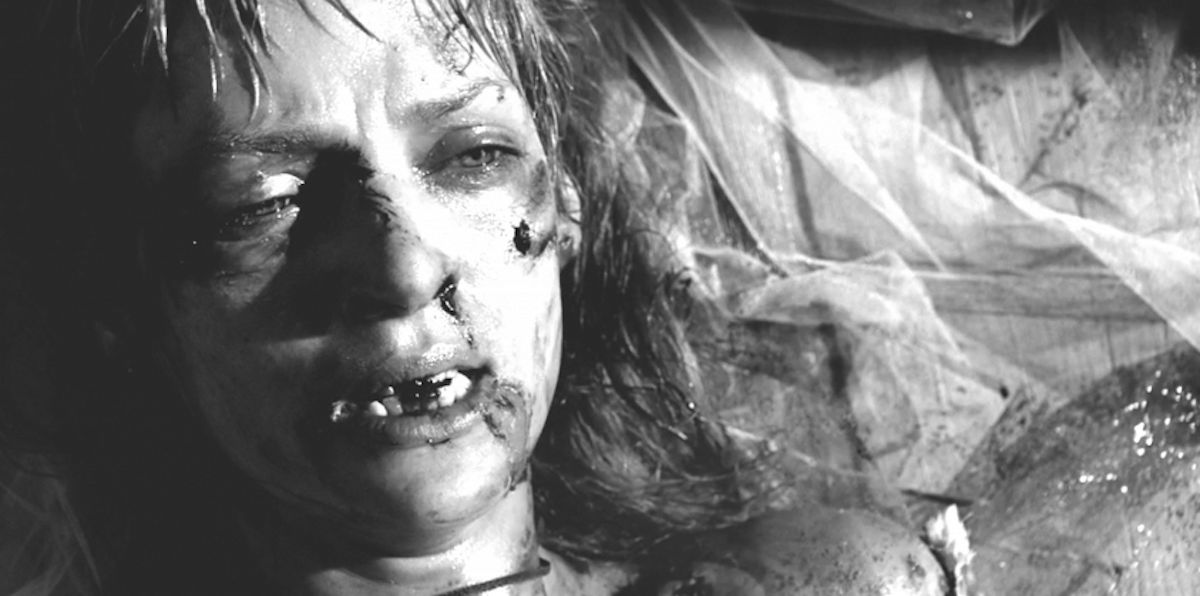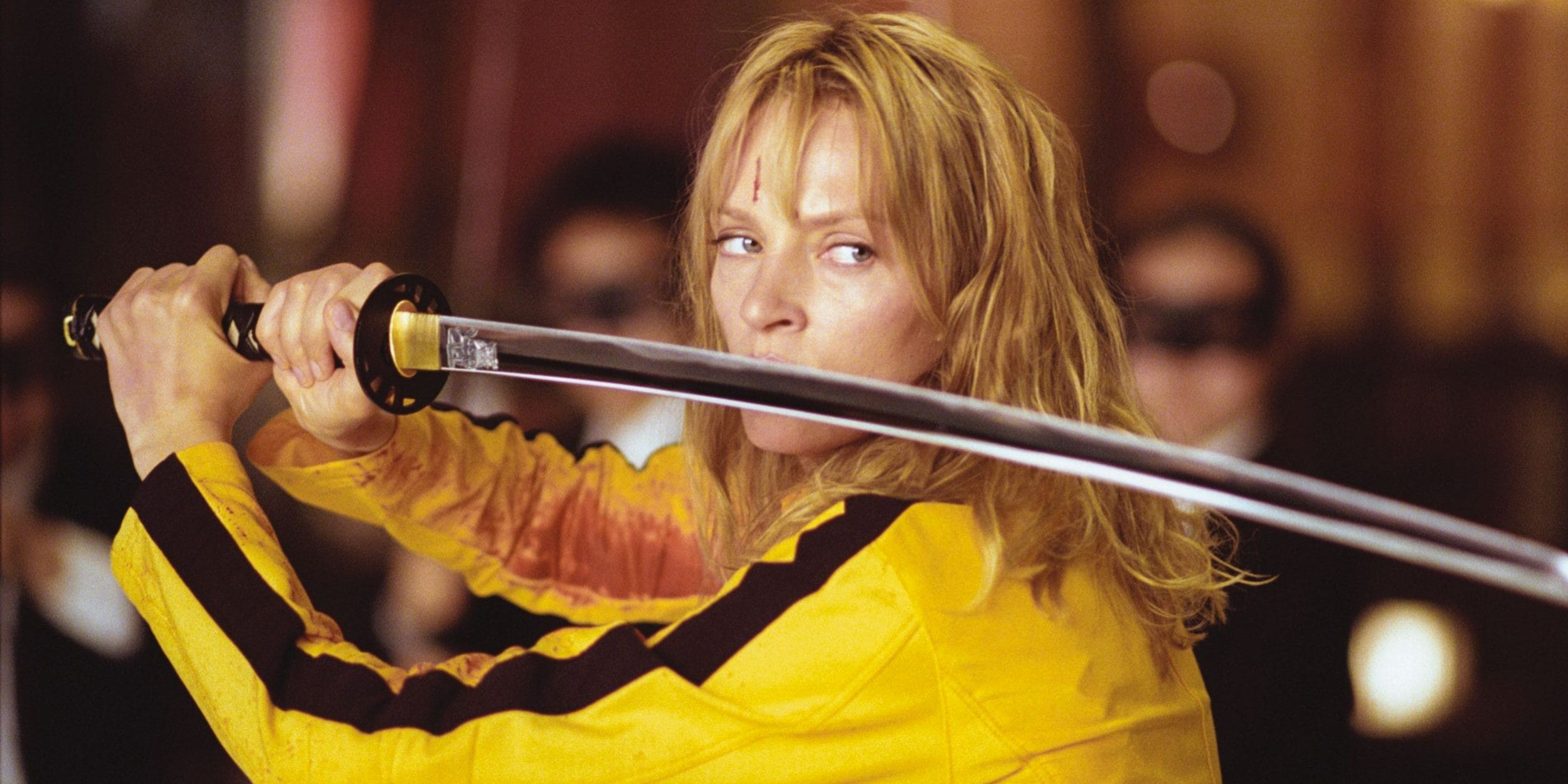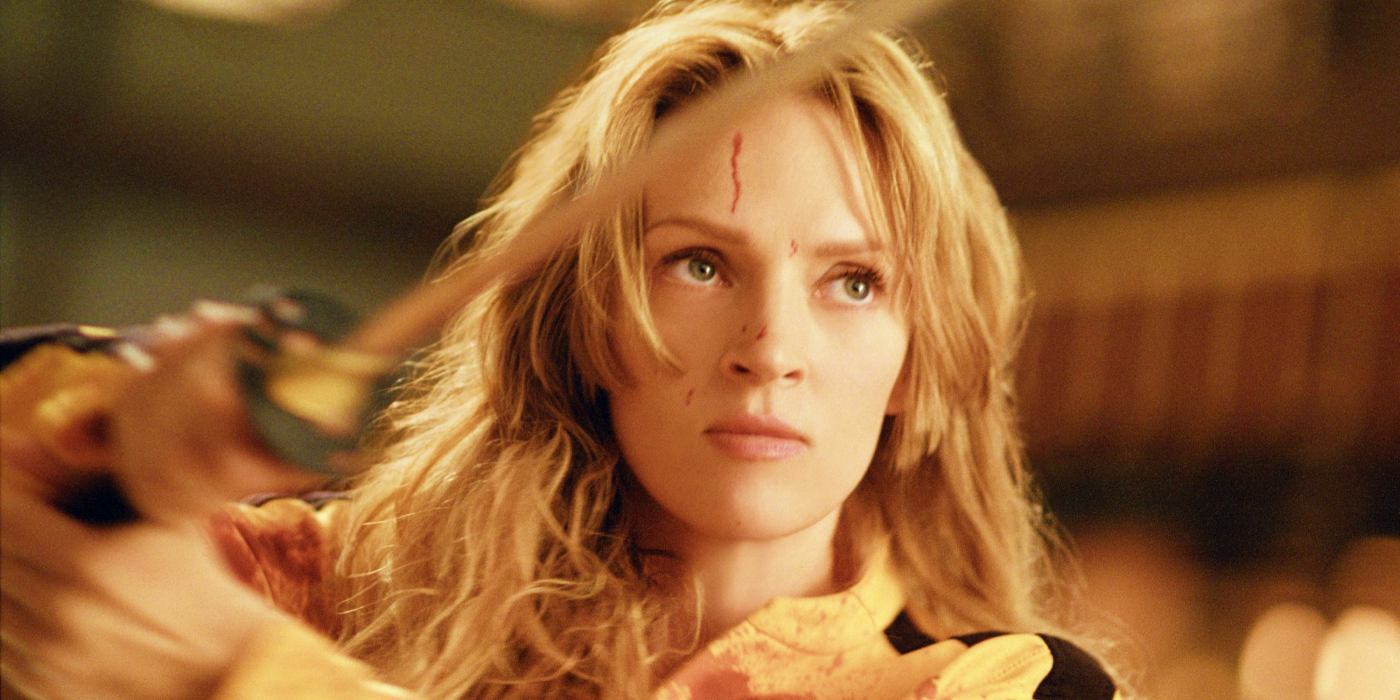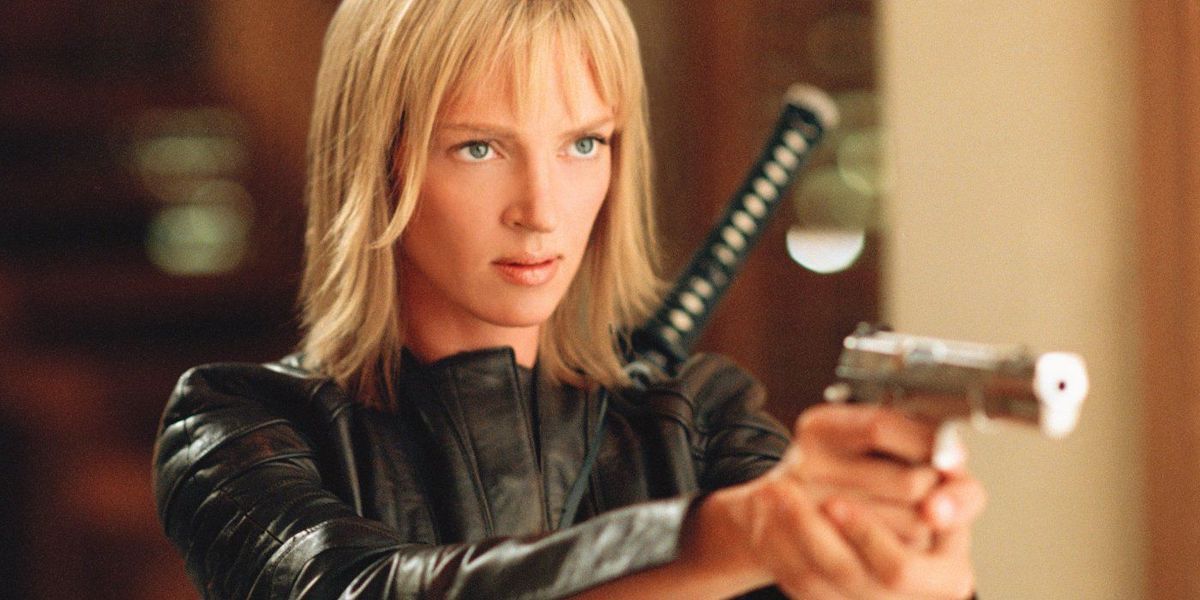In the opening shot of the roaring rampage of revenge action flick Kill Bill Vol. 1, we see an as-yet unnamed bride, cowering on the ground, bloody and beaten and staring down the barrel of a gun. While a wedding is often considered the beginning of a new life, this scene presents an alternative: a bride’s wedding day is not a beginning, but the end. Her white gown and the blood splattered across her face, dress, and veil, here presented in black-and-white, are even more ominous than if we could see the crimson against starched white. Bill (David Carradine) pulls the trigger, and with just this first shot, Kill Bill launches the process of telling not only a story of revenge, but also one of rebirth, through its costumes.
So The Bride (Uma Thurman) dies. At least, as the unnamed bride is shot in the head, this is what her assailant thinks. But the metaphorical death here carries just as much weight as Bill’s expectation of physical death. All the expectations of a wedding dress are therefore contrasted by the goriest metaphor of marriage at its worst: a man standing over the bride putting a bullet in her skull. While marriage has been peddled as the end-all be-all for women, and historically has remained an important factor for many women as it pertains to both survival and status, in The Bride’s instance it is also literally the end all — to happiness, to a chance at a normal life, to a family. From here, we see a stark juxtaposition in the way The Bride is presented to the viewer.
Having survived the gunshot to the head, The Bride arrives at the suburban home of Vernita Green (Vivica A. Fox), member of the Deadly Viper Assasination Squad. There is no time for words: as soon as the door opens and the sirens wail, the two women are thrust into a knife (and shelf and cereal) fight over the participation of Green in the slaughter in El Paso. For this rumble, The Bride is outfitted practically. Simple dark jeans, a thigh knife holster, and a tan leather jacket adorn the revenge-seeker, evoking the desperado simplicity of Butch Cassidy and the Sundance Kid. Because this is the first time we see The Bride after the assasination attempt, her transformation is all the more jarring. Though she says things that present a stark contrast to bridal showers and babymoons like, “It’s mercy, compassion, and forgiveness I lack,” the visual transformation gives us an even more emphatic reiteration of the warrior’s conviction of this character. As she emerges victorious, telling Vernita’s child to come find her someday, she is bloody and bitter, with the stoicism and machismo of legendary Western heroes and an outfit to match.
This pattern of communicating toughness through the evocation of American Western protagonists via wardrobe continues in Kill Bill Vol. 2, set in unspecified deserts, filled with neon-lit clubs and trailers hitched to nothing. Here, The Bride gives us more androgynous, borderline masculine clothing choices: snakeskin cowboy boots (knives included), straight-legged jeans, and typical western style button-ups in shades of sand. The scorned assassin climbs out of her coffin with the resolve of any Leone leading man, and is clad likewise.
By choosing outfits that are, if not referential to then at least evocative of, the lone-wolf-warrior of the Western canon, a sort of armored cocoon is constructed around our heroine. She was at her most vulnerable and unsuspecting as “The Bride,” wearing virginal white, delicate jewelry punctuating her ethereal dress. And behind all the carnage, though aided by several women, was the ultimate symbol of male dominance: Bill. If this man had the power to destroy her life, and to lead a team of world-class killers, The Bride (whether intentionally or not) tries to conjure up his power by emulating his wardrobe. Thus, the straight silhouettes and lonely cowboy ensembles not only imbue Beatrix with decades of cinematic source material to call upon during her journey, but also protect her, for however long, from the true, sinister misogyny of the crime. Like universities use Greek architecture to call to mind scholarship and history, The Bride uses her clothing to convince us, and herself, that she has what it takes to kill Bill.
In a similar vein, there’s the quintessential Kill Bill outfit: the yellow and black tracksuit. Though full of vibrant personality, the choice is in line with The Bride’s habit of sporting borrowed-from-the-boys outfits, in order to construct an air of authority. Influenced by (if not simply a modern interpretation of) the outfit Bruce Lee wore in Game of Death, the tracksuit is perhaps the most masculine-leaning clothing choice that The Bride dons; to face her first target, she literally fights in a man’s suit. Just as The Bride chooses ensembles that conjure up images of plains drifters saving damsels in distress in the great spaghetti westerns, this look accesses a strain of Eastern masculinity, chock full of combat prowess, for her trip to Japan.
When we see The Bride slice O-Ren’s head off, it first is represented as a splash of scarlet red on the snow; the parallel of the bloody snow and the white gown sprinkled in red act as the first tip of the scales of retribution, as another woman in white falls. Though The Bride requires a new tough-guy facade each new place she goes, when she’s not blanketed in the farce of the male warrior, she appears in totally anonymous, unspecific clothing.
Take the hospital for example. We flash back to an aborted assasination attempt by Elle Driver (Daryl Hannah) shortly after her hospitalization, and to the moment she wakes from the coma in an utterly faceless hospital gown. She then travels to Okinawa to commission a world’s-finest sword from Hattori Hanzo (Sonny Chiba), a retired samurai sword maker. He consents, and at the ceremony in which he offers the sword to The Bride, she wears a kimono, practically indistinguishable from her counterparts, once more lacking in individuality. In Vol. 2, we also see her as a student of the infamously cruel Pai Mei (Gordon Liu). This is the one instance where we see a splash of youthful femininity, when she is clad in a breezy peasant blouse and capri jeans, but this is long before Bill’s orchestrated massacre, and seemingly near the beginning of the duo’s relationship. Once accepted as a student, she wears a uniform, stripped of self-expression or any overt indication of femininity, mirroring the kimono costume while awaiting the sword from Hanzo.
These moments of anonymity are equally significant to the arc of The Bride’s costumes, as they are indicative of not only a stripping of the persona at the hands of Bill (both before and after the assasination attempt), but also of an internal struggle of self. She remakes herself, post-coma, into multiple cultures’ idea of what a strong, dauntless warrior should look like, demonstrating a lack of self-confidence, and providing evidence that the emotional side of her quest is incomplete.
Then comes the last big shift in Kill Bill’s costume storytelling saga. Having battled in the desert and Tokyo snow, defeating all who cross her path (or lucking out when they turn on one another), Beatrix Kiddo, finally named, hunts down her true, singular target: Bill. She tracks him to a hacienda in Mexico, for this final battle, the climax of her roaring rampage of revenge. And at this crucial moment, Beatrix Kiddo wears a skirt.
After seeing her kick and punch in jeans and leather and uniforms and found clothing, for the defeat of her oppressor, the architect of her pain and the patriarch of the Deadly Viper Assasination Squad, the once-nameless bride chooses her most feminine look of the film. It’s a voluminous, impractical, twirl-prone full-length skirt of soft baby blue.
Female renegades in film are often required to fill one of two categories: ultra-masculine to prove she’s tough (as we see earlier in the Kill Bill films), or thoroughly sexed-up to quell the audience’s fear of her being any real threat (think Cat Woman throughout her film history, or any supermodel-turned-assassin flick). Beatrix’s alternative provides a truer take on the intersection of woman and warrior: she is feminine, but only in the way an average American woman in 2004 would be, yet retains the ferocity she has cultivated throughout the films.
She kills Bill in this costume, and is reunited with her daughter. It’s unfortunate that Beatrix’s arc must stretch from “The Bride” to “Mommy” (as if those are the only two things a woman of 30-something can be); regardless, her rebirth is complete; the bride now has a name, a family, and a new life. As she writhes on the floor of the bathroom in one of the final scenes, grappling with all her losses and triumphs, she appears in all white once more, just as she was on the day of her dress rehearsal massacre. Kill Bill, in these final moments, cleans the slate that was once bloodied by the sins of its male oppressor.
And without a drop in sight, the blood-spattered bride becomes her true self at last. The lioness clad in white, ruler of the jungle.





